 “We’ll be tasting eight whiskies this evening,” Gregg said with a smile. The single malt scotches were lined up ready to go. Each had its own bottle shape with colors ranging from light amber to honey; some had gaelic inflected distillery names rich with consonant clusters; all represented the cream of the crop for Scotch whisky.
“We’ll be tasting eight whiskies this evening,” Gregg said with a smile. The single malt scotches were lined up ready to go. Each had its own bottle shape with colors ranging from light amber to honey; some had gaelic inflected distillery names rich with consonant clusters; all represented the cream of the crop for Scotch whisky.
Marsha and I were at the recently restored 1835 Meeting House at Mill Hill Historic Park for a tasting to benefit the Norwalk Historical Society. Beverage journalist Gregg Glaser guided us through seven single malts and one of the most coveted blended scotches in the world. He gave some background on the source, encouraged tasting comments from the audience, and shared the distilleries’ comments. Each bottle represented a distinctive style and reflected the traditions of its place of origin.
John Heffernan, Senior Master of Whisky, was also there to give insight into the whiskies, the places they’re made, and the people who make them. He has spent over 20 years studying scotch and is a recognized expert on the subject. Tall and imposing, wearing a kilt and full highland regalia, sporting an on and off Scottish accent and a cask of stories and jokes, he helped Gregg bring the subject to life.
The rules for making single malt whisky are strictly enforced: the ingredients must come from Scotland; it can only be made with malted barley; it must be distilled in Scotland in a pot still; and it has to be aged in oak barrels for a minimum of three years.
Malted barley is allowed to germinate and sprout, converting starch to the sugar that will ferment into alcohol. To stop the germination it is heated, often over a peat fire where the barley acquires the much-loved smoky character so typical of scotch.
To review: the barley is fermented, distilled to extract the alcohol, and then aged in oak barrels for a minimum of three years and often longer. The whisky is clear when it goes into the barrel and acquires all of its color and much of its nuanced flavor from the barrel aging. The type of barrel has a significant impact on the final flavor. Most barrels these days are used bourbon barrels from America. Towards the end of the aging period the whisky sometimes spends time in used sherry barrels, adding more color and subtle fruit flavors.
Gregg explained that there is no one right way to enjoy fine scotch. Neat or with ice (a few chips or cubes) are both OK. Adding just a few drops of water can help the whisky to “open up,” revealing nuanced flavors and aromas. The water, swirling through the whisky is said to “release the serpent.”
We tasted a wee dram of seven single malts, each with its own personality. They covered the five principal whisky regions, had alcohol levels from 40% to 46%, were aged from the minimum 3 up to 18 years, and had prices from $40 to $130 a bottle.
Tamdhu 10 year ($58) from Speyside had a golden color, notes of honey and vanilla and seemed, to me, to be a little “hot” with alcohol evident in the flavor.
Auchentoshan ($40) from the Lowlands had a delicate color with dried fruit flavors and a lighter mouthfeel. It’s notable for being triple distilled while most are distilled twice.
The Singleton of Glendullan 15 year ($50) is a Highlands whisky with a darker color from the long barrel ageing, caramel, fruitcake and dried cherries in the aroma, and a dry spicy finish. I liked this one a lot and it seemed a relative bargain for it’s age.
The Macallan Double Cask 12 year ($60), also from Speyside, was aged in both bourbon barrels and sherry casks. While most single malts have only a percentage finished in sherry barrels, this one has 100%. It had very pleasing sherry fruit and wine aromas and flavors. Macallan is a well known and widely available brand.
 Arran 10 year ($75) if from the Islands, specifically the Isle of Arran. With a medium color, it had a little sea air character and was, for me, a little hot in the finish, showing its 46% alcohol.
Arran 10 year ($75) if from the Islands, specifically the Isle of Arran. With a medium color, it had a little sea air character and was, for me, a little hot in the finish, showing its 46% alcohol.
Highland Park 18 year ($130), also from the Islands, is 100% finished in Oloroso sherry casks yielding lovely fruit notes. There was a delicate clean dry smoke aroma and flavor from the peat fire.
Kilchoman Machir Bay ($58) hails from the Isle of Islay (eye-la) where there are eight distilleries and only 2000 residents. (John calls this the happy island) The Smoke and wet peat dominated the aroma and flavor. It was the favorite of the hard-core single malt fans in the room.
The final Scotch of the evening was the legendary Johnny Walker Blue Label ($225). Like all Johnny Walker scotches, this is a blend, made to a house-style from whiskies distilled all over Scotland, some single malts and some not. It was a smooth, refined, and elegant drink, without some of the individual character of the single malts, but with the suave presence of a well-tailored tuxedo.
There are hundreds of single malt scotches, each a unique product from an individual place with a story to tell. If you get into it, there are endless opportunities to taste, enjoy, and collect. Let me know if you’re tasting – I’ll be happy to help out.

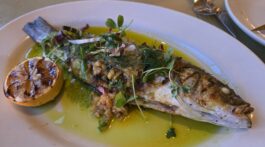
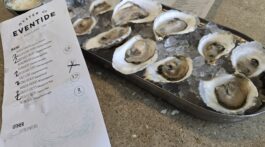





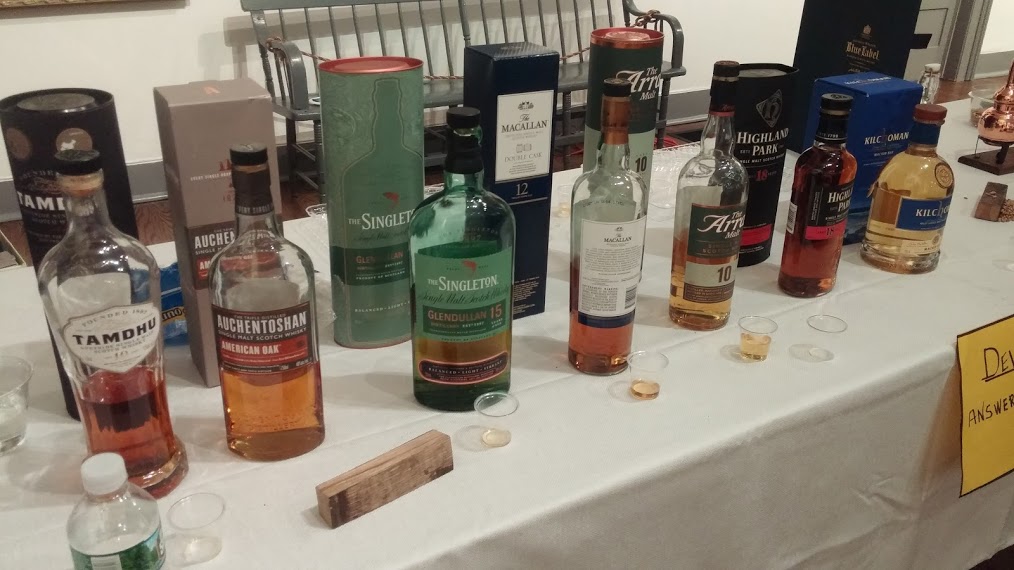
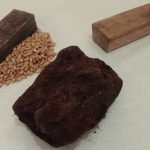


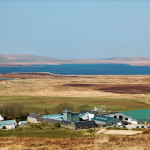
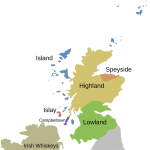

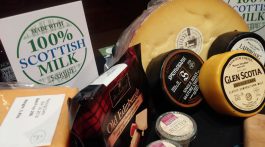
Well this was a “must read” for me! Glad to see you had the Macallan in the mix. BTW-For a blended, try the Johnny Walker Platinum. It’s about half the price of the Blue and darn near as good!
A side note: The bartender at Provenance cafe in the Cleveland Museum of Art is one of those hard core Scotch fans. He has an uncle that on birthdays will treat him to a Scotch that has been aged as many years as his own age. He is now 25; his uncle has to be going broke!